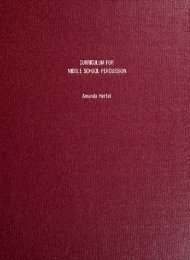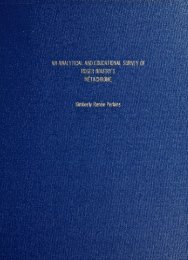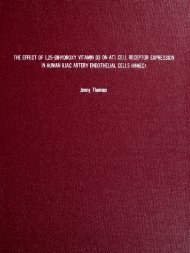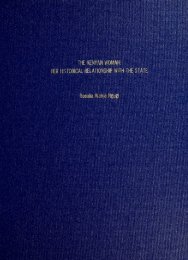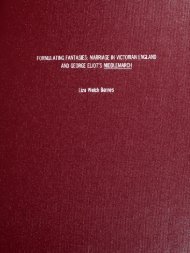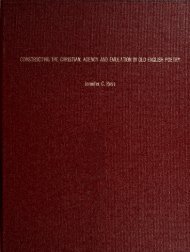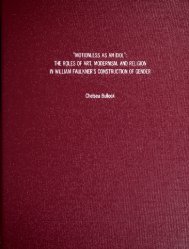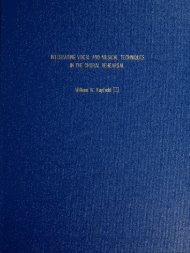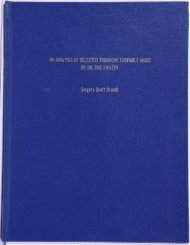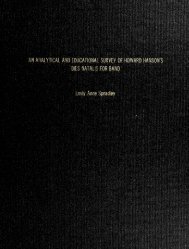The Effect of Aposematic Coloration on the Food Preference of ...
The Effect of Aposematic Coloration on the Food Preference of ...
The Effect of Aposematic Coloration on the Food Preference of ...
- No tags were found...
Create successful ePaper yourself
Turn your PDF publications into a flip-book with our unique Google optimized e-Paper software.
V. Aphelocoma coerulescens - Potential PredatorAphelocoma coerulescens, comm<strong>on</strong>ly called <strong>the</strong> Florida scrub jay, is a nati<strong>on</strong>allyclassified threatened species <str<strong>on</strong>g>of</str<strong>on</strong>g> bird endemic to <strong>the</strong> state <str<strong>on</strong>g>of</str<strong>on</strong>g> Florida. In 1993, this species wasestimated to have lost 90 percent <str<strong>on</strong>g>of</str<strong>on</strong>g> its original populati<strong>on</strong>, resulting in fewer than 4000 breedingpairs remaining throughout its habitat.This decline has been most directly attributed to <strong>the</strong> rapidloss and destructi<strong>on</strong> <str<strong>on</strong>g>of</str<strong>on</strong>g> <strong>the</strong> state's oak scrub habitat, which is essential to <strong>the</strong> survival <str<strong>on</strong>g>of</str<strong>on</strong>g> <strong>the</strong> birds(<str<strong>on</strong>g>The</str<strong>on</strong>g> Nature C<strong>on</strong>servancy and Audub<strong>on</strong> <str<strong>on</strong>g>of</str<strong>on</strong>g> Florida 2001).Scrub jays prefer to live in habitatcharacterized by low-growing shrubs, which serve as protecti<strong>on</strong> against nest predati<strong>on</strong> fromabove, and ground that is15-20 percent exposed sand, a property <str<strong>on</strong>g>of</str<strong>on</strong>g> <strong>the</strong> land that allows <strong>the</strong> birdsto cache foods with little difficulty.This habitat preference limits <strong>the</strong> areas that can sustain scrubjays to <strong>on</strong>ly seven locati<strong>on</strong>s al<strong>on</strong>g <strong>the</strong> Coastal Ridge <str<strong>on</strong>g>of</str<strong>on</strong>g> Florida (<str<strong>on</strong>g>The</str<strong>on</strong>g> Nature C<strong>on</strong>servancy andAudub<strong>on</strong> <str<strong>on</strong>g>of</str<strong>on</strong>g> Florida 2001).Scrub jays practice a unique behavior called cooperative breeding, in which <str<strong>on</strong>g>of</str<strong>on</strong>g>fspringremain with <strong>the</strong> parents and share <strong>the</strong> resp<strong>on</strong>sibilities <str<strong>on</strong>g>of</str<strong>on</strong>g> ga<strong>the</strong>ring food and caring for <strong>the</strong> nextseas<strong>on</strong>'s young.Only when <strong>the</strong>y find a mate do <strong>the</strong>y leave <strong>the</strong> cooperative breeding unit tobegin <strong>on</strong>e <str<strong>on</strong>g>of</str<strong>on</strong>g> <strong>the</strong>ir own.<str<strong>on</strong>g>The</str<strong>on</strong>g>y comm<strong>on</strong>ly feed <strong>on</strong> a wide range <str<strong>on</strong>g>of</str<strong>on</strong>g> food sources that variesaccording to whe<strong>the</strong>r or not it is <strong>the</strong> breeding seas<strong>on</strong>. During n<strong>on</strong>-breeding m<strong>on</strong>ths, <strong>the</strong> speciesfeeds primarily <strong>on</strong> large acorns, seeds, fruits, and nuts, many <str<strong>on</strong>g>of</str<strong>on</strong>g> which are stored earlier in <strong>the</strong>seas<strong>on</strong>.<str<strong>on</strong>g>The</str<strong>on</strong>g>ir diet is expanded during <strong>the</strong> breeding m<strong>on</strong>ths between March and June to includesmall insects and invertebrates as well as bird eggs and nestlings <str<strong>on</strong>g>of</str<strong>on</strong>g> o<strong>the</strong>r species (Ehrlich et al.1988). This diet indicates that Aphelocoma coerulescens shows interest in seeds and legumesand, <strong>the</strong>refore, would possibly resp<strong>on</strong>d to <strong>the</strong> warning signals <str<strong>on</strong>g>of</str<strong>on</strong>g> noxious seeds like those <str<strong>on</strong>g>of</str<strong>on</strong>g>Abrus precatorius.



